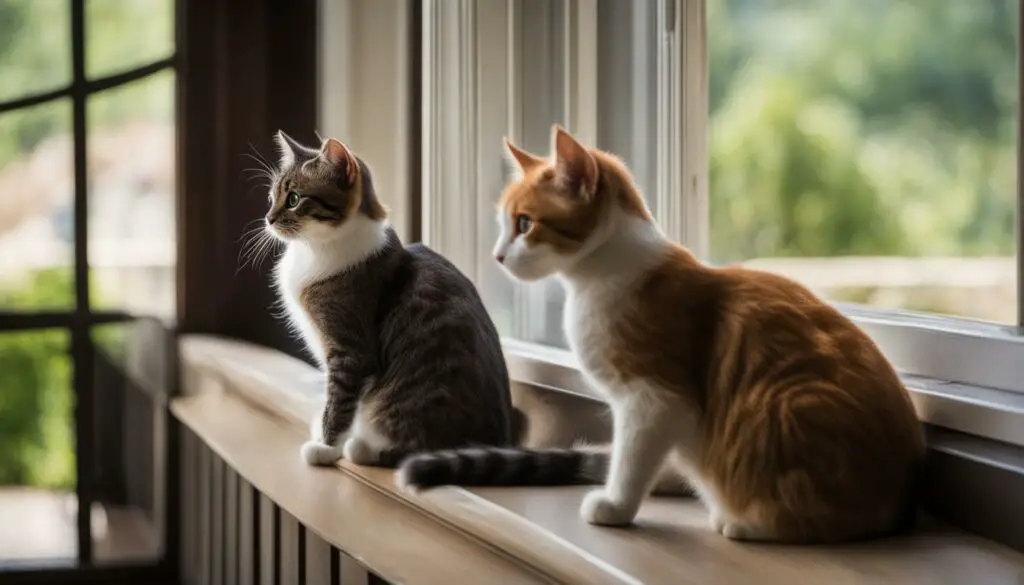Greetings! Today, I want to share some valuable insights on handling a cat that is jealous of a new baby in your home. It’s natural for cats to experience jealousy when their routine is disrupted and their territory and attention are threatened. By understanding the underlying causes of cat jealousy and implementing effective management strategies, we can create a harmonious environment where both our feline friends and infants can thrive.
Key Takeaways:
- Cats can experience jealousy when a new baby is introduced into their environment.
- Jealous behaviors in cats may include aggression, territorial behavior, excessive meowing, and litterbox problems.
- Understanding the reasons behind cat jealousy, such as insecurity, fear of losing possessions, and changes in the environment, can help address and prevent these behaviors.
- Preparing your cat for the baby’s arrival and gradually introducing them to baby-related items can ease the transition.
- Take precautionary measures to ensure the safety of both the cat and the baby, including supervising interactions and practicing good hygiene.
Do Cats Get Jealous of Babies?
Cats are known for their independent nature, but they can indeed experience feelings of jealousy when a new baby enters their home. This jealousy is often triggered by a change in routine and the fear of losing attention and territory. Understanding the emotions and behaviors associated with cat jealousy is crucial in managing and preventing any potential stress-related issues.
Jealous behaviors in cats can manifest in various ways, such as excessive meowing, aggression, or even litterbox problems. These behaviors are their way of expressing their unease and trying to reclaim their position and territory. As a cat owner, it is important to recognize and address these behaviors early on to maintain a harmonious environment for both your cat and new baby.
“Cats may exhibit jealous behaviors to establish dominance or protect their possessions,” says Dr. Sarah Thompson, a feline behavior specialist.
“Understanding their needs and providing positive reinforcement can help alleviate jealousy and promote a healthy relationship between the cat and baby.”
| Signs of Jealousy in Cats | Signs of Stress in Cats |
|---|---|
| Aggression towards the baby | Excessive grooming or licking |
| Marking territory with urine | Loss of appetite |
| Excessive meowing or vocalization | Isolation or hiding |
Addressing Jealousy in Cats
When it comes to managing cat jealousy, several strategies can help create a positive and balanced environment:
- Gradual introduction: Introduce your cat to the baby gradually, allowing them to get used to the baby’s scent and presence over time.
- Positive reinforcement: Reward your cat with treats, praise, and attention when they display calm and desirable behavior around the baby.
- Creating a safe space: Provide your cat with their own designated space where they can retreat when they feel overwhelmed or want some alone time.
- Maintaining routines: Stick to a consistent routine for your cat, ensuring they still receive attention and playtime without feeling neglected.
By implementing these strategies and addressing any signs of jealousy early on, you can promote a healthy relationship between your cat and baby. Remember, patience and understanding are key in creating a harmonious environment for everyone in your household.
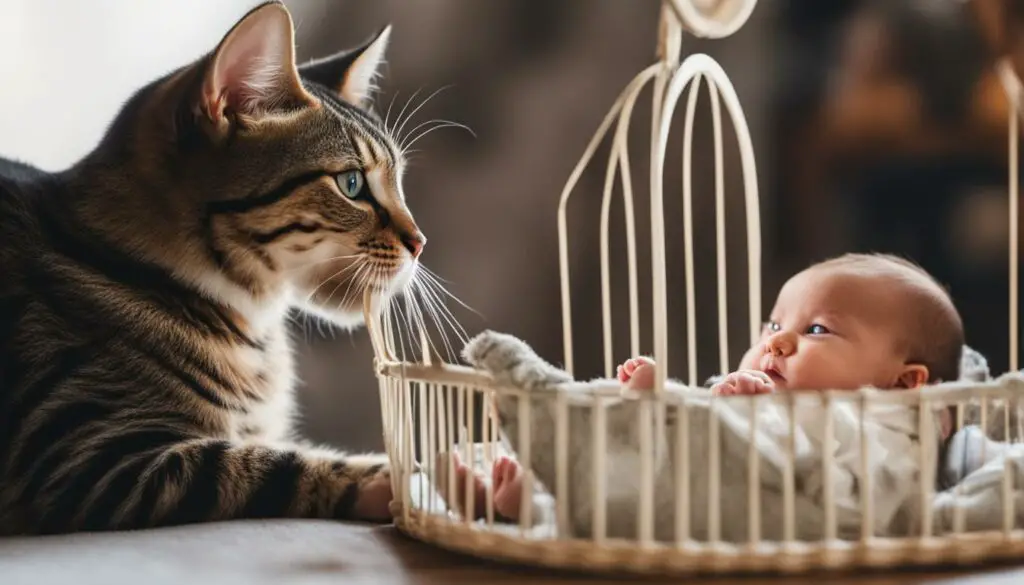
Why Do Cats Get Jealous?
Cats may experience feelings of jealousy due to various factors, including insecurity, fear of losing possessions, poor socialization, and changes in their environment. Understanding these underlying reasons can help us address and manage their jealousy effectively.
Insecurity is a common cause of jealousy in cats. They may feel uncertain about their place in the household hierarchy and become anxious when they perceive a threat to their position or resources. Cats are creatures of habit and can become stressed when their routines or territories are disrupted.
Poor socialization during kittenhood can also contribute to jealousy in cats. If they did not receive adequate exposure to different people, animals, and environments, they may struggle with change and feel uneasy when a new member, like a baby, is introduced into their living space. This lack of socialization can make them more prone to jealousy and fear.
Fear of Losing Possessions and Territory
Cats are territorial creatures, and they often have a strong sense of ownership over their belongings and space. When a new baby arrives, they may feel threatened and fear losing their possessions, such as their favorite sleeping spots or toys. This fear can trigger jealous behaviors as they try to protect their territory and maintain their sense of control.
Changes in the environment can also contribute to cat jealousy. Whether it’s a new baby, a move to a new home, or even changes in the household dynamics, cats can become stressed and anxious. These changes disrupt their sense of security and familiarity, leading to jealous behaviors as an attempt to regain control.
| Causes of Cat Jealousy | Examples |
|---|---|
| Insecurity | Fear of losing attention and resources |
| Poor Socialization | Limited exposure to new experiences and changes |
| Fear of Losing Possessions and Territory | Protecting favorite sleeping spots and toys |
| Changes in Environment | New baby, moving to a new home |
By recognizing and addressing these underlying causes of cat jealousy, we can help create a more harmonious environment for both our feline companions and our babies.

Signs of Jealousy In Cats
Cats may exhibit several signs of jealousy when a new baby enters the household. It’s important for cat owners to be aware of these signs to address and manage the jealousy effectively. Here are some common signs to look out for:
- Aggressive behaviors: Jealous cats may display aggression towards the baby or other family members. This can include hissing, scratching, or biting.
- Territorial behavior: Cats may become territorial and try to assert their dominance by marking their territory with urine or scratching furniture.
- Excessive meowing: Jealous cats may vocalize more than usual, seeking attention and expressing their frustration.
- Litterbox problems: Cats may exhibit litterbox problems, such as urinating or defecating outside of the litterbox. This can be a form of marking territory or a sign of stress.
These signs can indicate that your cat is feeling jealous and anxious. It’s essential to address these behaviors promptly to prevent further stress and create a peaceful environment for both your cat and the baby.
“When a cat feels threatened by the presence of a new baby, they may resort to displaying signs of jealousy as a way of protecting their territory and asserting dominance.”
Understanding and recognizing these signs of jealousy will enable cat owners to take appropriate measures to manage the behavior and minimize stress for everyone involved. By providing your cat with positive reinforcement, creating a safe and secure space for them, and addressing their needs, you can help alleviate jealousy and foster a harmonious relationship in your home.
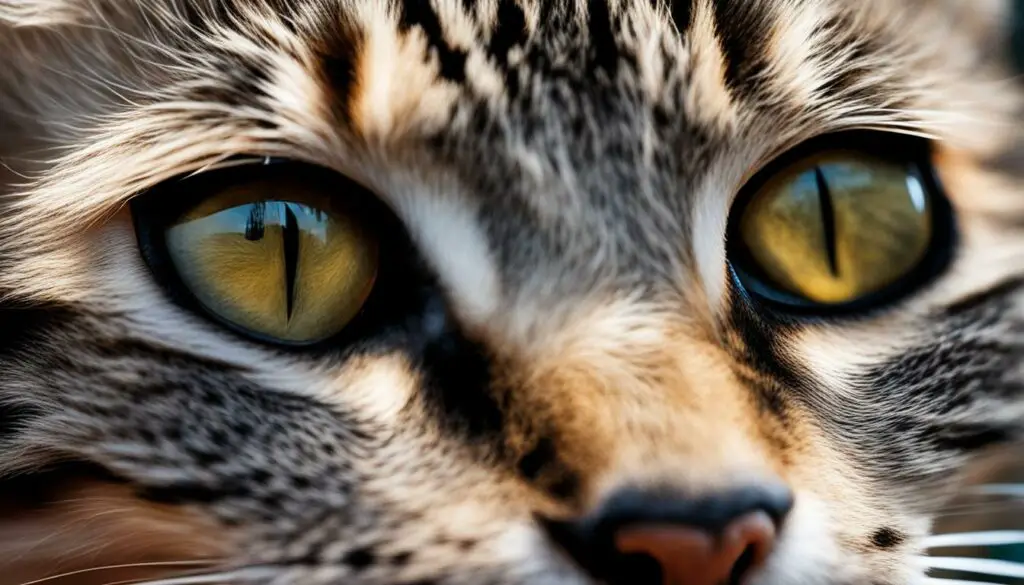
| Signs of Jealousy In Cats | Behavior Description |
|---|---|
| Aggressive behaviors | Hissing, scratching, biting |
| Territorial behavior | Marking territory with urine or scratching furniture |
| Excessive meowing | Vocalizing more than usual, seeking attention |
| Litterbox problems | Urinating or defecating outside of the litterbox |
How to Prepare Your Cat for Your Baby’s Arrival
Preparing your cat for the arrival of a new baby is an important step in creating a harmonious environment. By gradually acclimating your cat to the changes that come with a new baby, you can help reduce potential jealousy and ensure a smooth transition for both your feline friend and your growing family.
Changing Routines
One of the key ways to prepare your cat for the arrival of a baby is to gradually introduce changes in routines. Start by adjusting feeding and play times to mimic the schedule you will have when the baby arrives. This will help your cat adapt to the new routine and minimize any disruptions that may cause stress or jealousy.
Positive Reinforcement
Positive reinforcement is another effective method to prepare your cat for the baby’s arrival. Reward your cat with treats or praise whenever they exhibit calm and positive behaviors around baby-related items, such as cribs or strollers. This will create a positive association and help your cat see these items as non-threatening and even potentially enjoyable.
Additionally, consider setting up a designated area for your cat that includes their bed, toys, and scratching posts. This will give your cat a sense of ownership and security, reducing the chances of jealousy towards the baby.
| Preparing Your Cat for Your Baby’s Arrival | Do | Don’t |
|---|---|---|
| Gradually introduce baby-related items | Allow your cat to explore and investigate at their own pace | Force your cat to interact with the items |
| Keep routines consistent | Stick to regular feeding, play, and sleep schedules | Suddenly change routines without giving your cat time to adjust |
| Provide positive reinforcement | Reward your cat for calm and positive behaviors around baby-related items | Punish or scold your cat for displaying signs of jealousy or curiosity |
| Create a designated space for your cat | Set up a comfortable area with their bed, toys, and scratching posts | Remove your cat’s belongings or deny them access to certain areas of the home |
By following these preparation strategies, you can help your cat feel secure, confident, and accepted in the presence of the new baby. Remember to provide plenty of love, attention, and care to both your cat and your baby, and always supervise their interactions to ensure the safety and well-being of both.
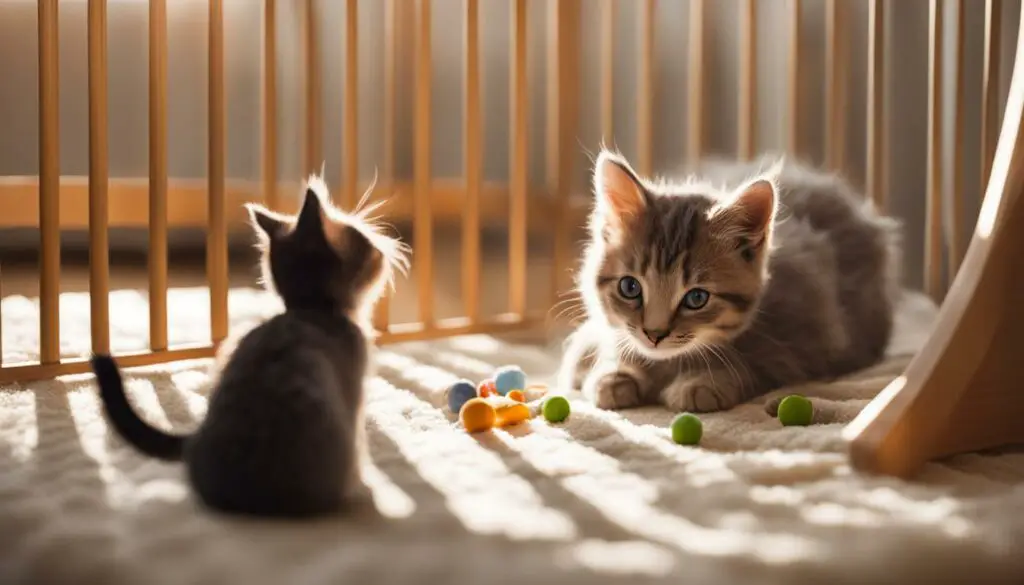
Cats and Babies – The Myths
When it comes to cats and babies, there are several myths that have circulated over the years. One of the most popular myths is that cats steal a baby’s breath. However, this is simply not true. Cats do not have the ability or inclination to steal a baby’s breath. This myth likely originated from the observation of cats cuddling up to babies, which is actually a display of affection rather than a dangerous act.
Another myth surrounding cats and babies is the danger of cats to infants. While it is true that cats can carry certain bacteria and parasites, the risk of transmission is relatively low if proper hygiene practices are followed. It is important to ensure that cats are regularly vaccinated, dewormed, and kept clean to minimize any potential risks.
“Cats do not have the ability or inclination to steal a baby’s breath.”
It is also worth noting that cats and babies can coexist safely in the same household. With proper supervision and gradual introductions, cats can often form a bond with their human siblings. However, it is essential to monitor interactions and provide a safe environment for both the cat and the baby to ensure their well-being.
| Myth | Facts |
|---|---|
| Cats steal a baby’s breath | False. Cats cuddling with babies is a display of affection, not a dangerous act. |
| Cats are dangerous to infants | False. The risk of transmission is low if proper hygiene practices are followed. |
By debunking these myths, we can better understand the relationship between cats and babies and ensure that both can thrive in a loving and safe environment. Remember, cats are often loving and gentle companions, and with the right precautions and care, they can coexist harmoniously with babies.
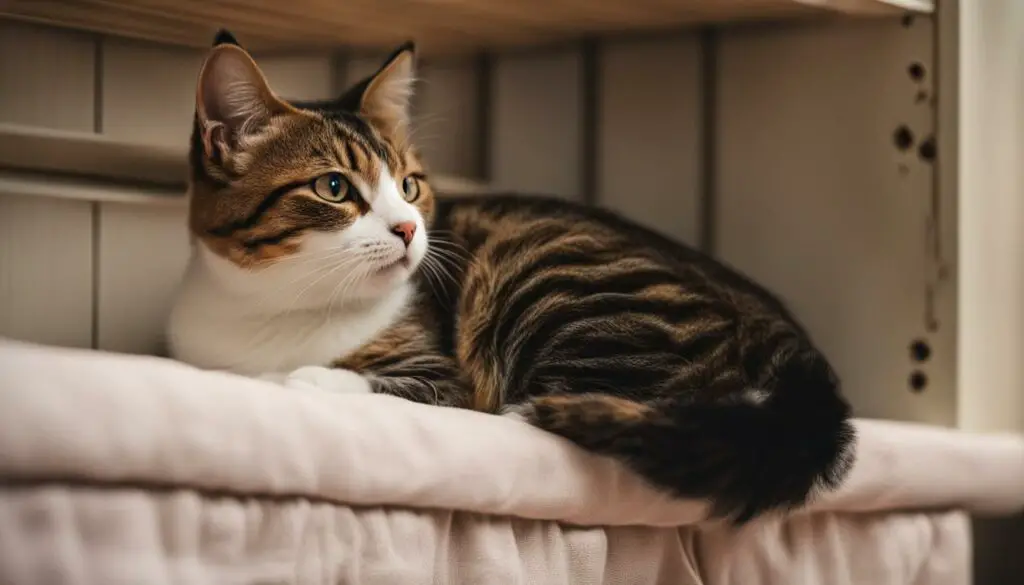
Cats and Babies – Safety Concerns
When it comes to the interaction between cats and babies, there are important safety concerns to be aware of. Taking preventive measures can help ensure the well-being of both your feline friend and your little one.
Suffocation Risk
Cats are naturally curious animals, and their curiosity can sometimes put babies at risk. To reduce the suffocation risk, it is crucial to never leave your baby unattended with a cat, especially during sleep time. Keep cribs and bassinets off-limits to your cat by using baby gates or doors. Additionally, avoid using loose bedding or blankets in the baby’s sleeping area to further minimize the risk.
Toxoplasmosis
Toxoplasmosis is a parasitic disease that can be transmitted to humans through contact with infected cat feces. Pregnant women and individuals with weakened immune systems are particularly vulnerable. To prevent the transmission of toxoplasmosis, pregnant pet parents should avoid cleaning the litter box and assign the task to a spouse, family member, or hire a professional. If no alternative is available, wear gloves and wash hands thoroughly after cleaning the litter box.
Cat Hair and Allergies
Cat hair can be a source of allergies for some babies. It is essential to keep your baby’s living space clean and free from excessive cat hair. Regularly vacuuming and using a HEPA filter can help reduce allergens. Additionally, consider keeping your cat out of the baby’s sleeping area and using hypoallergenic bedding and mattresses if necessary.
Cat Intestinal Issues
Cats may carry bacteria or parasites in their digestive tract that can be harmful to infants. To reduce the risk of transmission, always wash your hands thoroughly after handling your cat, especially before touching your baby or preparing their food. Avoid allowing your cat to lick your baby’s face or hands, as this can also increase the likelihood of exposure to potential intestinal issues.
| Risk | Preventive Measures |
|---|---|
| Suffocation | Never leave your baby unattended with a cat. Keep cribs and bassinets off-limits to your cat. |
| Toxoplasmosis | Pregnant pet parents should avoid cleaning the litter box. Wear gloves and wash hands thoroughly after cleaning if no alternative is available. |
| Cat Hair and Allergies | Regularly vacuum and use a HEPA filter. Keep your cat out of the baby’s sleeping area. Consider hypoallergenic bedding and mattresses. |
| Cat Intestinal Issues | Wash hands thoroughly after handling your cat. Avoid allowing your cat to lick your baby’s face or hands. |
Advice for Pregnant Pet Parents on Mixing Cats with Babies
As a pregnant pet parent, it’s important to take extra precautions when it comes to mixing cats and babies. Ensuring the safety and well-being of both your furry friend and your soon-to-arrive bundle of joy is essential. Here are some valuable tips and guidelines to help you navigate this exciting but potentially challenging time.
Table: Cat Litter Precautions
| Litter Precautions | Explanation |
|---|---|
| Delegate the litter duty | Have someone else in the household take over the task of cleaning the litter box. If this is not possible, make sure to wear gloves and wash your hands thoroughly after each cleaning. |
| Use a covered litter box | Investing in a covered litter box can help prevent your cat from accidentally contaminating the area with their waste. |
| Opt for low-dust litter | Choose a low-dust litter to minimize the risk of inhaling any potentially harmful particles. |
| Keep the litter box clean | Maintain a clean litter box by scooping it daily to help reduce the chances of bacterial contamination. |
Along with cat litter precautions, practicing good hygiene practices is crucial. Make sure to wash your hands thoroughly after handling your cat or cleaning the litter box. Maintaining a clean and hygienic environment for both your cat and your baby can help minimize any potential risks.
Another essential step is to ensure that your cat is spayed or neutered before the baby arrives. This helps prevent any potential behavioral issues related to hormones and reduces the likelihood of unwanted pregnancies.
By taking these precautions and following these guidelines, you can create a safe and healthy environment for both your cat and your baby, setting the stage for a harmonious and loving relationship to blossom.

Understanding Cat Behavior and Jealousy
Cat behaviorists agree that understanding cat behavior is key to addressing issues of jealousy in cats. Cats have their own social structure and may display behaviors that might be perceived as jealousy, such as territorial aggression and status-induced aggression. It is important to recognize and interpret these behaviors in order to provide appropriate responses and interventions.
Territorial aggression is one common behavior associated with jealousy in cats. This is when a cat exhibits aggressive behaviors to establish dominance and protect their possessions or territory. Signs of territorial aggression may include hissing, growling, swatting, and marking their territory with urine or scratching. Understanding the triggers and dynamics of territorial aggression can help in managing and redirecting this behavior.
Another form of aggression that may be perceived as jealousy is status-induced aggression. Cats are naturally hierarchical animals, and conflicts can arise when there are changes in their social status or hierarchy. This can occur when a new baby is introduced into the household, as the cat may feel threatened and challenged for attention and resources. Recognizing signs of status-induced aggression, such as bullying behaviors or excessive dominance displays, can help in addressing and resolving these issues.
| Types of Aggression | Description |
|---|---|
| Territorial Aggression | Occurs when a cat displays aggressive behaviors to establish dominance and protect their possessions or territory. Signs include hissing, growling, swatting, and marking territory. |
| Status-Induced Aggression | Arises from changes in social status or hierarchy, typically triggered by the introduction of a new baby. Signs include bullying behaviors, excessive dominance displays, and resource guarding. |
Understanding cat behavior and the underlying causes of jealousy is essential in effectively managing and addressing these issues. By recognizing the signs of territorial and status-induced aggression, pet parents can implement behavior modification techniques and provide appropriate outlets for their cat’s needs. It is important to create a safe and secure environment, establish a consistent routine, and reinforce desirable behaviors through positive reinforcement. Seeking guidance from a professional cat behaviorist can also provide valuable insights and strategies for managing cat jealousy.
Cats as Emotional Beings
As a cat owner, I have often wondered about the emotional depth of our feline friends. Do cats experience emotions like humans do? While we can never truly know what an animal is thinking or feeling, cats do display behaviors that can be interpreted as emotions by humans.
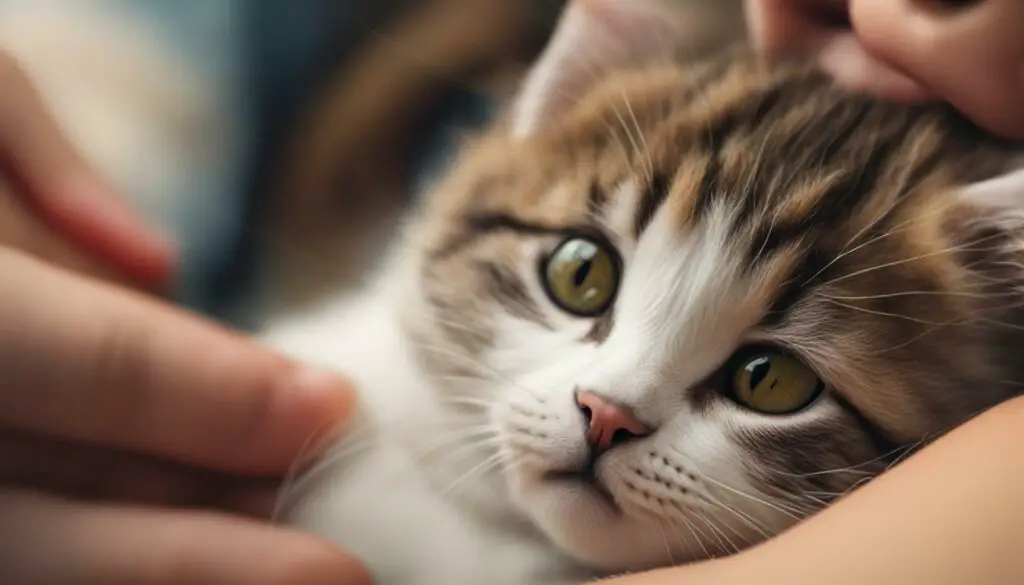
When my cat curls up on my lap and purrs contentedly, I can’t help but think she is feeling happy and loved. Similarly, when she arches her back and hisses at an intruder, it seems clear that she is feeling fear or anger. These behaviors, along with others like kneading, rubbing against objects, and vocalizing, can be seen as expressions of emotions in cats.
However, it’s important to remember that cats have their own unique ways of expressing their emotions. While we may assign human emotions and expressions to our cats as a way of joking or relating to them, it’s essential to recognize that cats experience the world differently than we do. They have their own set of instincts, needs, and ways of communicating.
The Complexity of Cat Emotions
While we may not fully understand the intricacies of cat emotions, it’s clear that they are capable of experiencing a range of feelings. Cats can feel joy, contentment, fear, anger, sadness, and even jealousy. These emotions are influenced by various factors, including their environment, social interactions, and overall well-being.
It’s important for cat owners to be attentive to their feline companion’s emotional needs and provide a nurturing environment that promotes their emotional well-being. This includes providing mental stimulation, engaging in play, and creating a safe, stress-free space for them to retreat to when needed.
In conclusion, while we may never fully understand the complexities of cat emotions, it is evident that they experience a range of feelings. As responsible cat owners, it is our duty to recognize and respect their emotions, providing them with the love, care, and understanding they deserve.
Is Cat Behavior Jealousy or Something Else?
When it comes to understanding cat behavior, it can be easy for us humans to interpret their actions through our own lens of emotions and intentions. This phenomenon, known as anthropomorphism, often leads to misconceptions about why cats behave the way they do. While it is natural to attribute human-like emotions to our feline friends, it is important to recognize that their behavior may stem from different causes.
Cat behavior interpretation requires a deeper understanding of their instincts and natural behaviors. Rather than assuming jealousy as the sole explanation for certain actions, it is crucial to consider other possible causes. Cats are territorial animals and may display aggressive behaviors to establish dominance or protect their possessions. This territorial aggression can be mistaken for jealousy, but it is driven by their innate nature to defend their resources.
Other factors that can influence cat behavior include fear, stress, and changes in their environment. Cats are sensitive to disruptions in their routines, and the introduction of a new baby can trigger feelings of insecurity and anxiety. It is crucial to provide a safe and secure environment for our cats and understand that their behavior may be a response to these changes rather than jealousy alone.
“Understanding cat behavior requires us to look beyond human emotions. By focusing on their natural instincts and needs, we can better address their behavior and provide them with the care they require.” – Cat Behavior Specialist
Causes of Cat Behavior
To delve further into the causes of cat behavior, it is essential to consider various factors that can contribute to their actions. These include:
- Past experiences and socialization during kittenhood
- Changes in their environment, such as moving to a new home
- Feeling threatened by the presence of a new baby or other animals
- Physical discomfort or medical conditions
By understanding these underlying causes, we can address cat behavior more effectively. It is important to consult with a professional and seek expert advice to determine the true cause of our cat’s behavior and develop an appropriate response.
| Cause | Description |
|---|---|
| Past experiences and socialization during kittenhood | Cats with limited exposure to different environments and experiences during their early development may exhibit fear or aggression in response to new situations. |
| Changes in their environment | Moving to a new home, rearranging furniture, or introducing new pets or humans can disrupt a cat’s sense of security and trigger behavioral changes. |
| Feeling threatened by the presence of a new baby or other animals | Cats may perceive the arrival of a new baby or the presence of other animals as a threat to their territory or source of attention, leading to behavioral changes. |
| Physical discomfort or medical conditions | Cats may exhibit changes in behavior due to pain, discomfort, or underlying medical conditions. It is crucial to rule out any potential health issues. |
How to Address Jealousy in Cats
Addressing jealousy in cats requires a combination of behavior modification techniques and positive reinforcement. It is important to create a safe and secure environment for your cat, providing them with appropriate outlets for their needs. This can include scratching posts, interactive toys, and dedicated playtime. By redirecting their focus and energy onto these activities, you can help alleviate feelings of jealousy.
In addition to environmental enrichment, reinforcing desirable behaviors is crucial. Whenever your cat displays positive interactions with the baby or shows contentment in their presence, offer praise and rewards. This positive reinforcement helps strengthen the association between the baby and positive experiences, reducing jealousy over time.
“By redirecting their focus and energy onto these activities, you can help alleviate feelings of jealousy.”
Consistency is key when addressing jealousy in cats. Stick to a regular schedule for feeding, playtime, and attention, ensuring that your cat receives their fair share of love and attention. This helps reduce feelings of competition and reinforces the notion that there is enough love to go around for both the cat and the baby.
Remember, addressing jealousy in cats is a process that requires patience and understanding. If you are unsure about how to handle your cat’s jealousy or if their behavior becomes aggressive or concerning, it is recommended to consult with a professional cat behaviorist or veterinarian for personalized guidance and support.
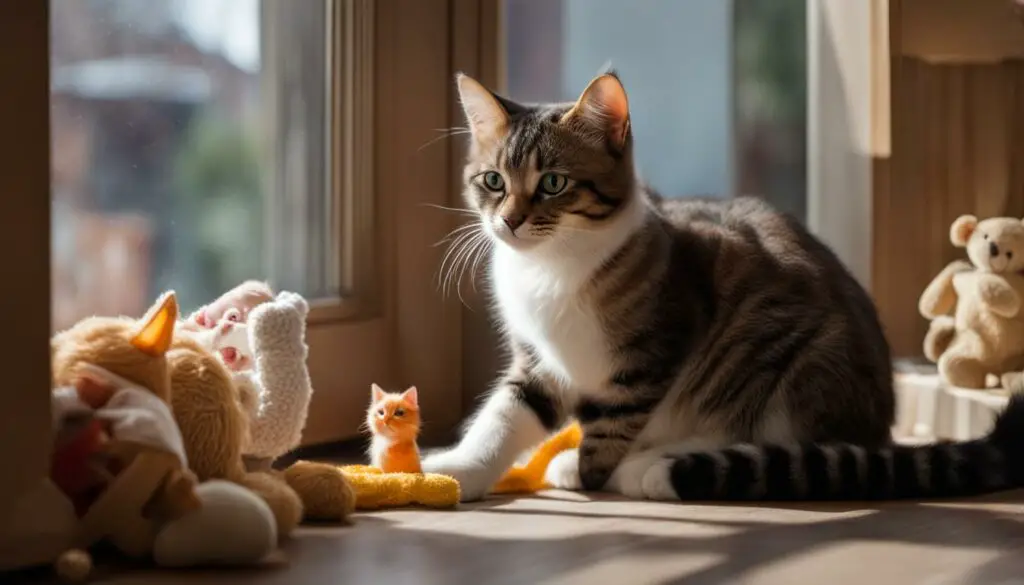
Table: Behavior Modification Techniques for Addressing Jealousy in Cats
| Technique | Description |
|---|---|
| Environmental Enrichment | Provide your cat with physical and mental stimulation, such as scratching posts, interactive toys, and playtime, to redirect their focus away from jealousy. |
| Positive Reinforcement | Reinforce desirable behaviors displayed by your cat when in the presence of the baby through praise, treats, or play. This helps create positive associations and reduces jealousy over time. |
| Consistency | Maintain a consistent schedule for feeding, playtime, and attention for both the cat and the baby. This helps establish fairness and reduces competition for affection. |
| Professional Guidance | If unsure or if your cat’s behavior becomes concerning, seek guidance from a professional cat behaviorist or veterinarian for personalized support and advice. |
Managing Jealousy Between Cats and Babies
Managing jealousy between cats and babies requires a thoughtful approach, gradual introduction, and supervised interactions. It is important to create a safe and positive environment for both the cat and the baby, ensuring that they can coexist harmoniously. Here are some key strategies and guidelines to help you navigate this delicate process:
Gradual Introduction
Introduce your cat to the baby gradually, allowing them to become familiar with each other’s scents before any direct interactions. Start by placing baby blankets or clothing near your cat’s sleeping area, allowing them to become accustomed to the baby’s smell. Gradually increase the exposure by having supervised interactions in a controlled environment where the cat feels safe.
Supervised Interactions
Always supervise interactions between your cat and your baby to ensure the safety of both. It is essential to never leave them alone together, especially in the early stages of the introduction. Monitor your cat’s body language and behavior closely, looking for signs of stress or aggression. If any negative behavior occurs, separate them immediately and consult with a professional if needed.
Creating a Positive Association
Help your cat associate the presence of the baby with positive experiences. Reward your cat with treats or praise when they are calm and relaxed around the baby. Provide them with their favorite toys or treats while the baby is nearby, creating positive reinforcement for their good behavior. This will help your cat associate the baby with positive experiences and reduce any feelings of jealousy or resentment.
Remember, managing jealousy between cats and babies is a gradual process that requires patience and understanding. With consistent efforts and positive reinforcement, you can create a harmonious environment where both the cat and the baby can thrive.
| Managing Jealousy Between Cats and Babies | Key Strategies |
|---|---|
| Gradual Introduction | Introduce the cat and the baby slowly and safely, allowing them to become familiar with each other’s scents before direct interactions. |
| Supervised Interactions | Always monitor interactions between the cat and the baby to ensure their safety, never leaving them alone together. |
| Creating a Positive Association | Reward your cat with treats and praise when they display calm and relaxed behavior around the baby, helping them associate the baby with positive experiences. |
Creating a Harmonious Environment for Cats and Babies
Providing a harmonious environment for both cats and babies is essential for fostering love and acceptance. Building a strong sibling bond between them is not only beneficial for their well-being but also creates a peaceful and happy home. Here are some key strategies to ensure a harmonious coexistence:
1. Introduce them gradually
When bringing a new baby into the household, it’s important to introduce them to your cat gradually. This helps your cat become familiar with the new family member and reduces any feelings of jealousy or insecurity. Start by allowing your cat to sniff and explore the baby’s belongings, such as blankets or toys, before introducing direct interactions.
2. Establish fair attention and resources
Make sure to provide fair attention and resources to both your cat and baby. Your cat may feel jealous or neglected if all attention is shifted solely to the baby. Set aside special time each day to spend with your cat, engaging in activities they enjoy. This can help them feel valued and prevent jealousy from arising.
Avoid favoritism and ensure that both your cat and baby have access to their own spaces, toys, and resources. This helps prevent competition and territorial disputes, promoting a harmonious environment for all.
3. Promote positive interactions
Encourage positive interactions between your cat and baby to foster a strong sibling bond. Always supervise their interactions to ensure the safety of both parties. Use positive reinforcement, such as rewards and praise, when your cat displays calm and gentle behavior around the baby. This helps create positive associations and strengthens their bond over time.
| Benefits of a harmonious environment for cats and babies: |
|---|
| 1. Emotional well-being: A harmonious environment helps reduce stress and anxiety for both cats and babies, promoting their emotional well-being and overall happiness. |
| 2. Social development: Cats and babies can learn valuable social skills from each other, such as empathy and cooperation, which contribute to their healthy social and emotional development. |
| 3. Companionship and love: A harmonious environment allows cats and babies to form a deep and lasting bond, providing them with a lifelong source of companionship and unconditional love. |
By following these strategies, you can create a loving and harmonious environment where cats and babies can thrive together, forming a unique and special bond that lasts a lifetime.

Conclusion
In summary, managing cat jealousy when a new baby enters the home requires a thoughtful and empathetic approach. Understanding feline behaviors and addressing jealousy with appropriate techniques is essential for promoting harmony between cats and babies.
By practicing cat jealousy management techniques such as behavior modification and positive reinforcement, we can create a harmonious environment where both cats and babies can thrive. Gradual introductions, supervised interactions, and providing designated spaces for cats can help foster a positive relationship.
Remember, promoting a strong sibling bond and ensuring fairness in attention and resources are crucial for creating a loving and balanced home. Understanding the needs and behaviors of both cats and babies allows us to navigate jealousy and create a secure environment for all family members to coexist happily.
So, let’s embrace the challenge of handling a cat jealous of a baby with empathy and patience, and watch as love and acceptance flourish, creating a beautiful bond between our feline friends and our little ones.
FAQ
Do cats get jealous of babies?
Yes, cats can experience jealousy when a new baby is introduced into their environment.
Why do cats get jealous?
Cats can get jealous due to feelings of insecurity and fear of losing possessions or safety.
What are the signs of jealousy in cats?
Signs of jealousy in cats can include aggression, territorial behavior, excessive meowing, and litterbox problems.
How can I prepare my cat for my baby’s arrival?
You can prepare your cat for your baby’s arrival by gradually introducing them to baby-related items and maintaining a consistent routine.
Are there any myths about cats and babies?
Yes, there are common myths surrounding cats and babies, such as cats stealing a baby’s breath, but these are not true.
What are the safety concerns when it comes to cats and babies?
Safety concerns include the risk of suffocation, transmission of toxoplasmosis, cat hair allergies, and potential spread of cat intestinal issues.
What precautions should pregnant pet parents take when mixing cats and babies?
Pregnant pet parents should avoid direct contact with cat litter, practice good hygiene, and ensure cats are spayed/neutered.
How can I understand cat behavior and jealousy?
Understanding cat behavior involves recognizing territorial aggression and status-induced aggression.
Are cats emotional beings?
While we can never truly know, cats do display behaviors that can be interpreted as emotions by humans.
Is cat behavior jealousy or something else?
Cat behavior can be misinterpreted as jealousy due to anthropomorphism, but consulting with a professional can help determine the cause.
How do I address jealousy in cats?
Addressing jealousy in cats requires behavior modification techniques and positive reinforcement.
How can I manage jealousy between cats and babies?
Managing jealousy involves gradual introduction and supervised interactions between cats and babies.
How can I create a harmonious environment for cats and babies?
Creating a harmonious environment involves promoting love and acceptance, fostering a sibling bond, and ensuring fairness in attention and resources.

